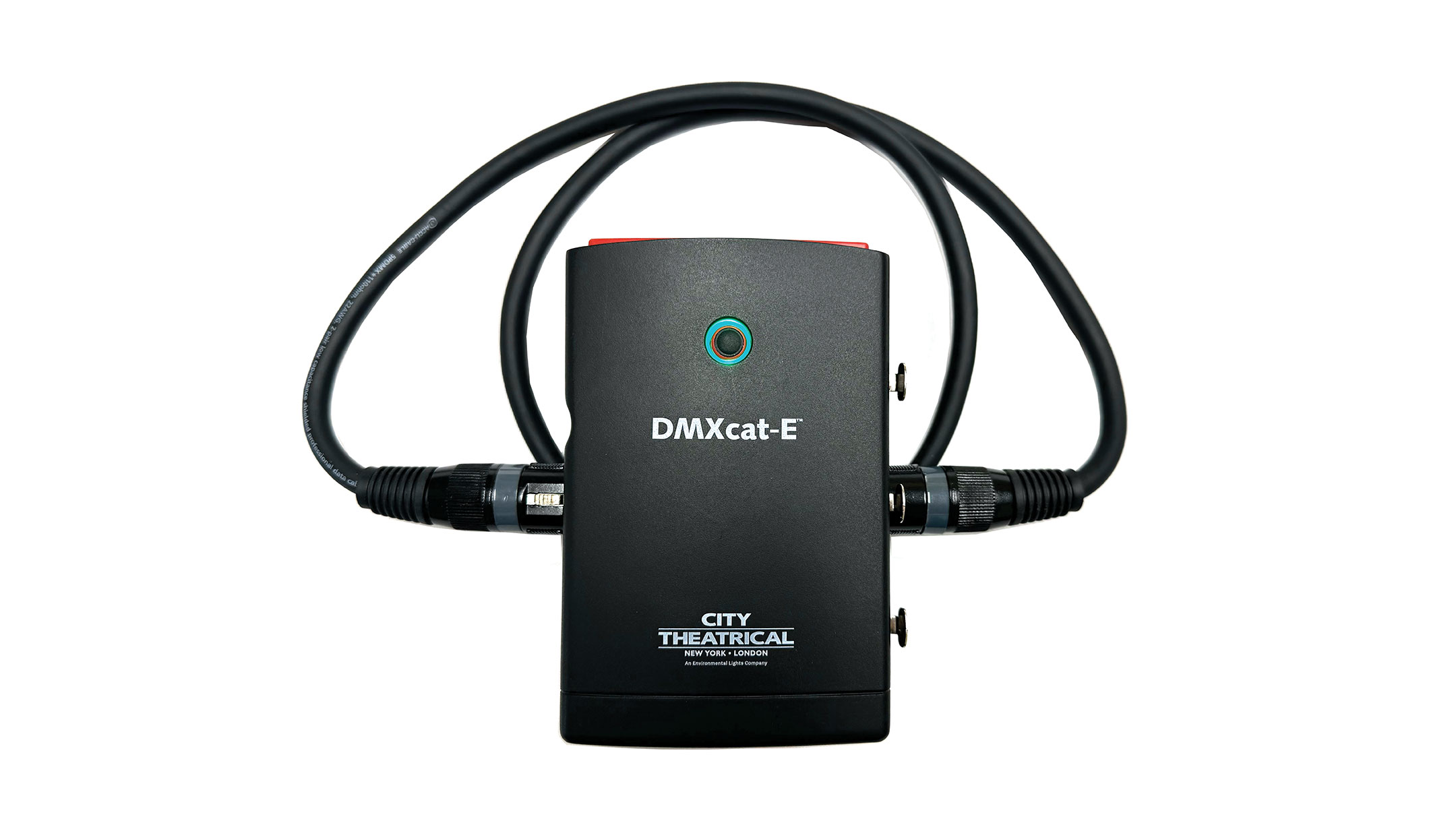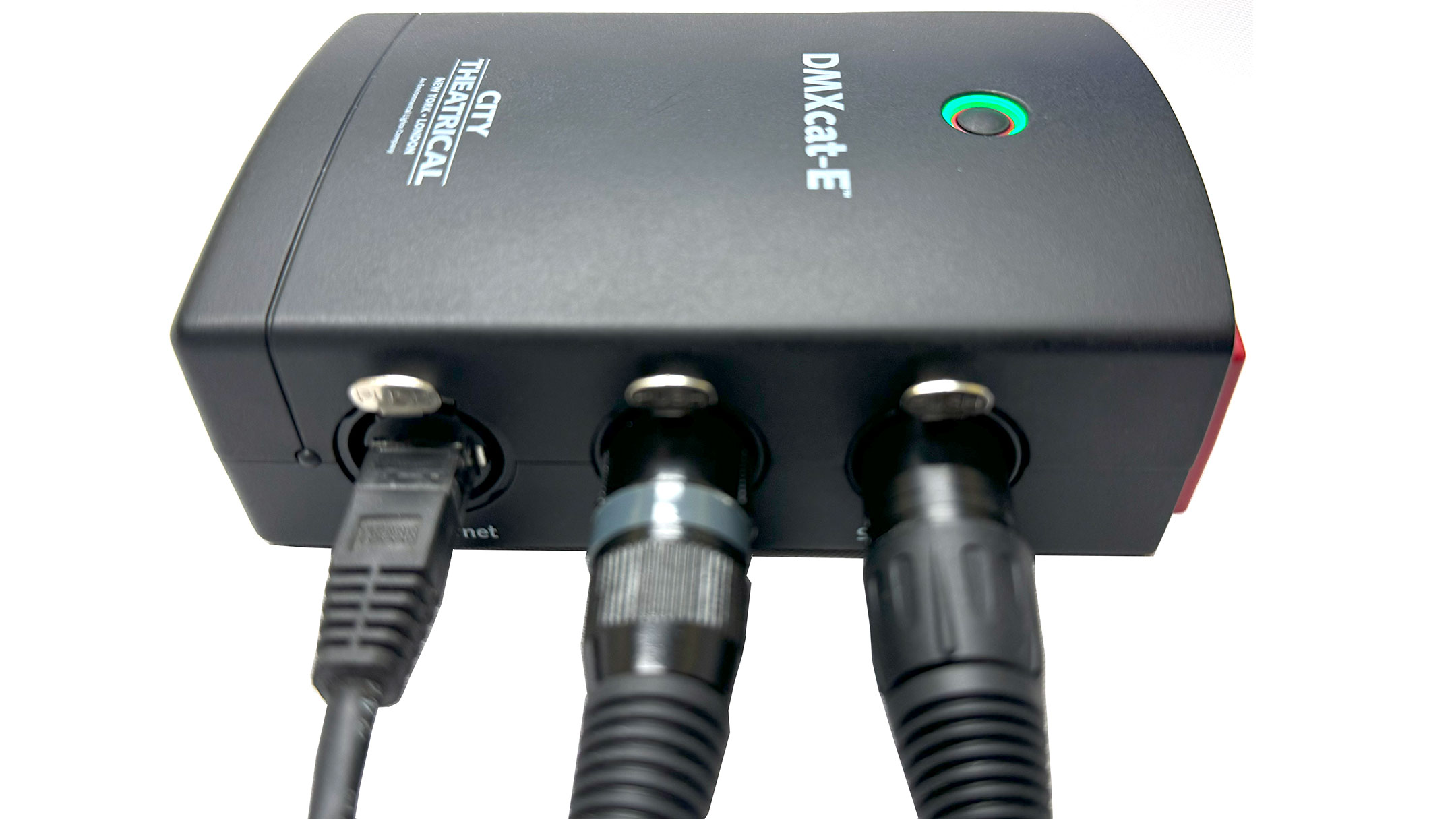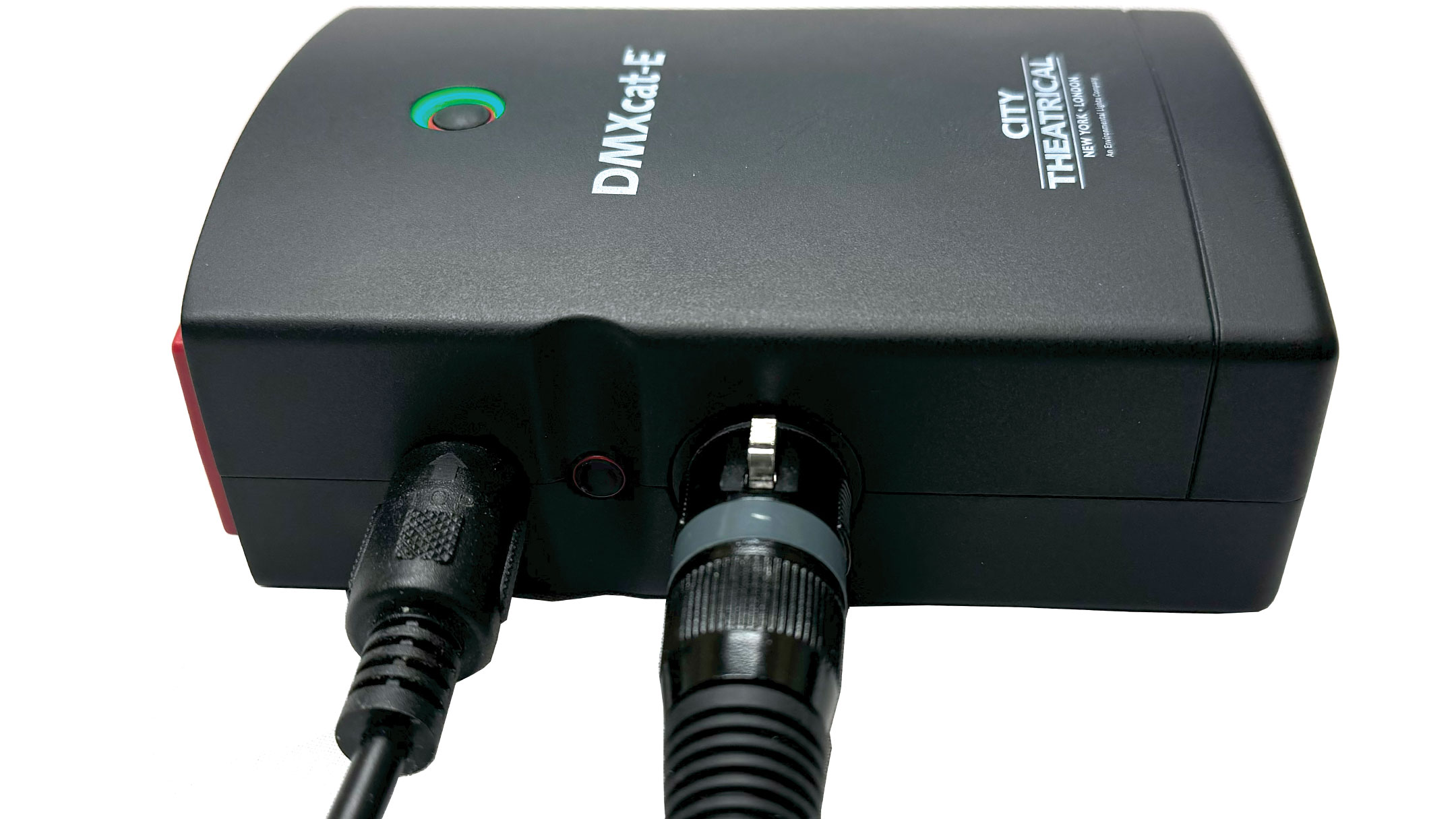
Adam Seidman accepting two product awards on behalf of City Theatrical at LDI 2023
City Theatrical talked to Adam Seidman, who is an Electrical Engineer on the engineering team at City Theatrical, during October 2024 to learn more about the development of the highly anticipated DMXcat-E™.
His role covers the new electronic product development process at City Theatrical, including the design, analysis, prototyping, hardware development, and R&D of new products, including the LDI 2023 product award-winning Multiverse® Connect Module and Wing Nut Socket, as well as the DMXcat-E.
Adam graduated from the Rochester Institute of Technology where he studied Computer Engineering.
City Theatrical talked to Adam to learn more about the development process for the newest City Theatrical product, DMXcat-E, which was introduced at LDI 2023, and some insider tips and tricks into how users can best use it, once it starts shipping in Q4 2024.
Read our Employee Spotlight interview with Adam Seidman on DMXcat-E below.
EMPLOYEE SPOTLIGHT INTERVIEW WITH ADAM SEIDMAN:
City Theatrical (CT): Hi Adam! Thanks for taking the time to tell us about the newest City Theatrical product, DMXcat-E™, and how it was developed.
First, can you tell us what the green light on the DMXcat-E device does or shows?
Adam Seidman (AS): Hi! Thank you for having me. This green light underneath the button towards the top of the DMXcat-E device is the power light. In general, when the light is green, it's on.
When it is on but not connected to a phone, the green LED does a slow fade. When you connect to the DMXcat-E, it becomes solid green. When the battery is low or there is DMX present, the green light flashes rapidly.
While it's charging, this light will be red. DMXcat-E is charged via USB-C fast charging.
The other light on the DMXcat-E device is the Ethernet link light. Green indicates that there is link and red tells you that there is Ethernet activity.
Of course, DMXcat-E also includes a flashlight, like the original DMXcat.
CT: For people who have used DMXcat before, how do they get started with DMXcat-E for the first time?
AS: For both new users and existing users of DMXcat who have already downloaded the DMXcat app alike, on first connection with DMXcat-E there will be a software update that will take about 15 minutes. Users need to keep their phone charged and close to the DMXcat-E during this first time, for the entire time.
From there, the DMXcat app will be able to connect to their DMXcat-E device easily and use all the same DMXcat apps they love as well as the new DMXcat-E functionality in one place.
"The new DMXcat-E contains all of the same features as the original DMXcat. This includes one of the XLR ports, the flashlight, buzzer, and power light. Basically everything else is new – it’s a DMXcat but with a ton more options and functions. There are four more connectors and a lot more features. The DMXcat-E is also larger in size than the DMXcat. It also comes with a pouch included in the box as opposed to an add-on accessory."
- Adam Seidman, Electrical Engineer, City Theatrical
CT: What’s the biggest difference between the new DMXcat-E and the DMXcat device?
AS: The new DMXcat-E contains all of the same features as the original DMXcat. This includes one of the XLR ports, the flashlight, buzzer, and power light.
Basically everything else is new – it’s a DMXcat but with a ton more options and functions. There are four more connectors and a lot more features.
The DMXcat-E is also larger in size than the DMXcat. It also comes with a pouch included in the box as opposed to an add-on accessory.
CT: What are some of the new functions of DMXcat-E?
AS: On the DMXcat app, the new functionality when connected to a DMXcat-E device are pretty much covered by the five new apps:
- Ethernet - The Ethernet app allows users to view the sources on the network, like the Main Console, Backup Console, and Button Stations. It allows users to ping devices on the network, or make a list of IP address and ping them all at once. The Ethernet app is also where users can change IP settings.
- Cable Testing - The Cable Testing app works in two ways:
- For 5-pin DMX, users can use the two XLR connectors on the device to test DMX cable.
- For Ethernet, users just plug in one end and it will verify the cable is wired correctly, as well as tell you the cable length.
- PoE Tester - The PoE Tester app allows users to see the voltage(s) on the RJ45 cable.
- The PoE Tester also specifies the classification of the attached network switch.
- Timecode - Timecode is an application designed to verify the Timecode signal coming from any timecode generator that generates MIDI or SMPTE. This app also allows users to make a click track that can be uploaded to the lighting console.
- MIDI - The MIDI application shows all MIDI data on the DIN connector. Users can use it as a “sanity check” to make sure you’re seeing what you’re supposed to see on the wire.
The DMXcat-E costs a bit more than the DMXcat, but it includes features for cable testing that I personally have spent more than the difference on for just that, not to mention all of these other new functions.

CT: How do you use the new Cable testing app?
AS: With Cable Testing, users can use the XLR to connect a cable to the DMXcat-E. The app would tell me that a conductors are connected to what, whether it’s connected to another wire or two, and whether it is accidentally connected to two or three wires together.
You can test RJ45 cables of any length with the new Cable Testing app, and your DMXcat app will tell you how long it is.
DMXcat-E sends out signals over an RJ45 cable, and then it measures how long it takes those signals to bounce back. It uses those signals that return to determine the cable length. If any of the wires are crossed or shorted together, the app will tell the user based on how the signal bounces back.
In fancy words, it's called, time domain reflectometry. It is used to determine the cable length and then it uses the shape of the wave that comes back to determine if any of the wires are in the wrong place.
Users can then look in the DMXcat cable testing app to see all of this information.

CT: How do you think this cable testing function will be used on entertainment lighting projects?
AS: While everyone works differently, I’ve seen installations in which lighting professionals will cut their wires to the lengths they want and put a connector on the end. For me, it would be very useful to plug it in and quickly and easily see if I made the connector correctly without physically laying it out to measure it or checking the individual wires manually.
CT: Are you able to test five-PIN XLR and the RJ45 cables in a similar way?
AS: Yes, you go into the Cable Tester application in the DMXcat app and click one of them. Our users can go back and forth between the two, as many times as they desire. The only difference is that users will hear relays clicking when you chose to test XLR cables.
CT: Was the DMXcat-E designed to have more ports than the original DMXcat?
AS: Yes, it was. The DMXcat-E has a lot more options than the DMXcat.
Not everyone will use everything. But each of these functions are very useful additional features that add to the DMXcat experience.

CT: Can you tell us more about the MIDI application?
AS: Sure. There are plenty of things you could send over this. There's MIDI timecode, which is the application with the running time. There are other protocols such as show control that we are still developing, which can send you lighting cues, among other things.
With MIDI, just as with the Timecode application, some data can be stored with it. If you leave the DMXcat-E plugged in, the app will also tell users the last time it saw MIDI.
CT: What is the difference between MIDI and Timecode applications?
AS: The timecode app shows MIDI and SMPTE timecode. It will select between the DIN and XLR3 connectors based on the user’s selection.
The MIDI app shows MIDI data (such as notes, i.e. Note On/Channel 2), show control (lighting cues - this is not yet implemented fully), and also MIDI timecode. The MIDI app essentially shows anything that would show up on the DIN connector.
Both applications show the data coming in real time.
“With DMXcat-E, users can set a 'group'. All these IPs brought together in a group will report back the times of all of them. Art-Net can be put on the line and talk to a bunch of fixtures, as users can do with the original DMXcat, but DMXcat-E also enables them to use RDM over the Ethernet if the light fixture has Art-Net RDM. I guess we will see, once users get their hands on their new DMXcat-Es!”
- Adam Seidman, Electrical Engineer, City Theatrical
CT: Does a user need to be near their DMXcat-E to use the smartphone app?
AS: The DMXcat-E uses BLE technology and has a decent range. The range is somewhat longer than the original DMXcat. A lot of users will likely plug it in to their network and walk away to go attempt to fix/change things.
Additionally, if you can’t find your DMXcat-E, you can take advantage of the alert mode and it will start making loud noises and flashing the flashlight, making it easier to locate.
CT: What do you think is going to be the most popular feature on the DMXcat-E?
AS: The Ethernet Testing by far, because it’s got very useful features for both streaming ACN and Art-Net.
With the sACN, users can send it out and receive it via DMXcat-E, see what's on the line, ping each light fixture in the app.
With DMXcat-E, users can set a “group”. All these IPs brought together in a group will report back the times of all of them.
Also, Art-Net can be put on the line and talk to a bunch of fixtures, as users can do with the original DMXcat, but DMXcat-E also enables them to use RDM over the Ethernet if the light fixture has Art-Net RDM.
I guess we will see, once users get their hands on their new DMXcat-Es!
CT: Thank you very much for your time, Adam, looking forward to seeing what comes next as well!

L - R: Adam Seidman of City Theatrical, Drew DeCorleto from 4Wall, and Harrison Hohnholt and Gary Vilardi of City Theatrical at City Theatrical's booth at LDI 2023.
Learn more about DMXcat-E
Explore DMXcat-E's newest features and benefits. City Theatrical will be shipping preorders in Q4 2024.
Discover DMXcat-E
Become Part of our Team
City Theatrical has been inventing and manufacturing award winning products and technology for over 36 years. Even if you have never heard of City Theatrical, chances are you have seen our industry-trusted products brought to life in productions for live entertainment on Broadway stages, architectural installations, major television shows and film projects around the world. Want to be part of the team that invents, manufactures, and customizes unique lighting accessories for projects like Stranger Things, NBC’s The Tonight Show, SNL, America's Got Talent, U2’s 360 Tour, Hamilton, The Lion King, and many others?
Check out our jobs page and apply today.